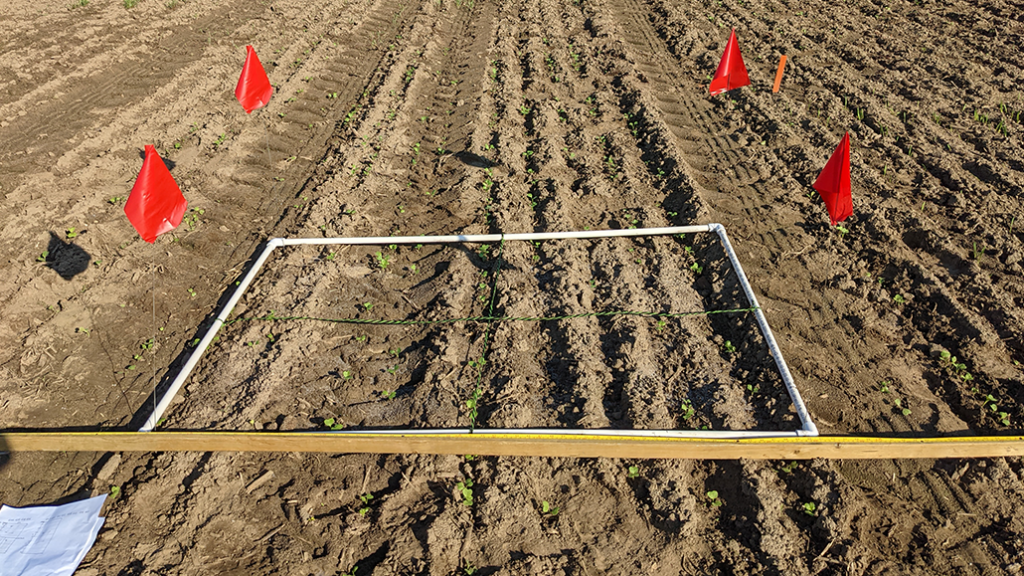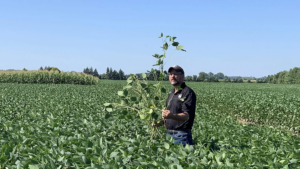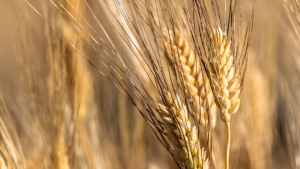Nitrogen management research
NEW PROJECTS OFFER MORE INSIGHT AND KNOWLEDGE

EXCITING PROGRESS HAS already been achieved with four new nitrogen-focused research projects supported, in part, by Grain Farmers of Ontario. All projects started in 2022, and the teams in the first three projects are based at the University of Guelph.
CARBON FOOTPRINT RESEARCH
First up is a project that will provide a carbon footprint for the production of corn, wheat, soybeans, and spring cereals, headed by Dr. Claudia Wagner-Riddle and Dr. Alfons Weersink, with colleagues Dr. Laura Van Eerd and Dr. Joshua Nasielski.
A grain farm’s ‘carbon footprint’ includes all greenhouse gas (GHG) emissions, with emissions generally expressed as carbon dioxide equivalent (CO2eq) per year or per amount of product produced.
On a grain farm, GHG emissions come from running equipment and drying grain but also take the form of nitrous oxide (N2O) from fertilizer application. N2O emissions total about 4,500 kilotons of CO2eq annually in Ontario, representing about 45 per cent of the agricultural GHG emissions in the province.
Wagner-Riddle explains that more accurate grain production carbon footprint calculations for Ontario allow us to better track farm progress towards emission targets and demonstrate the on-farm efficiencies being achieved. These more accurate values can also be used to market Ontario-produced grain.
The team will also investigate whether there is a link between a farm’s reduced carbon footprint and improved profitability and identify opportunities for carbon footprint reduction.
Wagner-Riddle explains that the carbon footprint of grains has not generally included soil organic carbon changes. “The main driver of carbon footprint values tends to be soil carbon gain or loss and nitrogen fertilizer use,” she says.
In terms of what individual producer practices could matter most in carbon footprint reduction, Wagner-Ridder points to crop rotation diversification with the inclusion of winter wheat, spring cereals, and cover crops as having the potential to offset nitrogen use through improved soil health, and can also result in soil carbon gains.
While this team might or might not find a link between a reduced carbon footprint and a better farm business bottom line, several practices may help farmers do both, building on the precision ag advancements that many Ontario farmers have already worked hard to implement.
“Optimizing of nitrogen rate could increase profitability and reduce the carbon footprint,” says Wagner-Riddle. “[Various fertilizer] products also have this potential if they increase nitrogen use efficiency and allow for rate adjustments.”
COVER CROPS AND NITROGEN
Can cover crops enhance nitrogen availability to corn while, at the same time, also enhancing organic nitrogen and carbon storage in the soil? Dr. Laura Van Eerd and Ph.D. student Yajun Peng are looking into this question from the view of long-term versus first-time cover crop use among Ontario grain farmers. Also included in this project are Wagner-Riddle and Anne Verhallen, soil management specialist at the Ontario Ministry of Agriculture, Food and Rural Affairs (OMAFRA).
Cover crops have been widely touted for their ability to increase soil organic nitrogen and carbon storage, but farmers generally see these benefits over many years. Putting in a cover crop also requires some upfront costs. This makes some farmers hesitant to try cover crops or give up on them fairly soon. In short, some farmers view cover crops as a potential waste of their time.
“To reduce this risk, we will assess economic and environmental performance (reduce nitrogen inputs and mitigate nitrogen losses) of long-term and first-time cover cropping compared to not cover cropping,” explain Van Eerd and Peng.
On the economics front, they anticipate that grain corn yields in the long-term cover crop plots in this study will show what’s already been demonstrated in other studies — that corn yields are significantly greater in long-term cover crop plots than in those without. Yet another long-term cost savings from cover cropping for Ontario grain corn producers is the reduced rate of nitrogen fertilizer needed.
In this project, the team is using ’15N-enriched fertilizer’ to trace the pathway of applied nitrogen. “Without the 15N tracer, we don’t know if nitrogen in the crop came from the fertilizer or from mineral nitrogen in the soil,” explains Peng. “We applied 15N-enriched fertilizer at cover crop planting, so we will know how much fertilizer the cover crops took up in shoots and roots and how much remains in the soil to the three-foot depth in the late fall and following spring. Then, we can follow nitrogen fertilizer transfer into the following corn crop in terms of the grain, stover, roots and soil. This helps us understand how cover crops take up nitrogen and how that nitrogen is transferred to the following crop.”
As to which cover crops might eventually be recommended once this project is complete, Peng says, “in this experiment, there is no compelling evidence to recommend one specific cover crop over another. Thus, we suggest farmers pick the one that fits into their rotation and meets their goals.”
The most exciting part of this project for Peng is having long-term versus first-time cover cropping versus no cover cropping in the same field. “We can look at different cover crop species and also compare different time scales,” she says. “We are excited to provide Ontario cover crop data to support farmer decision-making.”
LEGUME-BASED COVER CROPS
In another cover crop project, Dr. Kim Schneider, graduate student Daniel Colcuc, and Dr. Elizabeth Lee (with colleagues Dr. John Lauzon and Jake Munroe, OMAFRA soil management specialist) are determining the effectiveness of legume-based cover crops in providing nitrogen benefits to a subsequent corn crop.
The researchers note that red clover that is frost-seeded in the spring into a standing winter wheat crop has been shown to demonstrate significant nitrogen credit benefits to a subsequent corn crop in southwestern Ontario. However, red clover stands frequently suffer from non-uniformity across a field, which has reduced their uptake by farmers. Annual cover crops planted after winter wheat harvest, specifically those that include legumes, are a potentially very good alternative to red clover — providing a nitrogen credit to the following crop in the same way.
One legume cover crop option, Balansa clover, is available in the Ontario market and is being promoted for its nitrogen-fixation capabilities, but little data is available on its ability to supply nitrogen when planted as a late-season cover crop.
Colcuc says that so far, Balansa clover and the other annual legumes they chose to plant — berseem clover and Austrian winter peas (AWP) — had very mixed results when planted following the winter wheat harvest. “In order of performance, the legumes were ranked for aboveground yield with AWP averaging 1060 kg/ha or 945 lbs/ac and berseem clover averaging 766 kg/ha or 683 lbs/ac,” he says. This year, Balansa clover was not harvested due to low growth.
Schneider adds that because they had seen some promising results in plot trials with berseem clover planted in early June, they wanted to see how it would do planted post-winter wheat (planted around early August). “We wanted to include the legumes as both monocultures and mixtures in order to be able to confidently say which species is providing the nitrogen credit,” she says. “However, if a farmer were to harvest a cover crop for forage, they would be more likely to plant the legume in a mixture with a cool season annual grass like oats, for example. This will increase the yield and make it more suitable as a feed. But we wanted to see if there would still be enough legume in order to provide a nitrogen credit. Preliminarily, the grasses do compete with the legumes, so sometimes there was not much legume left when planted in a mixture. The AWP likely did the best in the mixtures.”
And how might the uniformity of red clover stands be improved? One way is to alter winter wheat row spacing. Lee explains, “I think that the general consensus is that red clover stands become highly variable when wheat yields are high, meaning wheat is out-competing the red clover for light and/or moisture. There had been some farmer research on Twitter about dropping every third row in a conventional wheat stand that my master’s student Brett Hilker came across, and this intrigued him. He suggested that we include that as an additional treatment in his trials. And wow, what a difference it made.”
Lee says of their conclusions on that front so far, “first take-home message: twin row wheat under high-yield conditions results in considerably high red clover stands, but there is a variety effect. Second take-home message: if you want good red clover stands, it starts with picking the right wheat variety. We do not know exactly what is going on here, but it is not competition for light. Our current working hypothesis is that some wheat varieties have better water use efficiencies and therefore are not as hard on the underseeded red clover. Last take-home message: “The higher the red clover stand, the higher the subsequent corn grain yield is.”
IMPROVING 4R
In this project, the well-known and highly-implemented 4R commercial fertilizer nutrient stewardship practices are being refined for Ontario crop farmers in corn and soybean production systems currently or previously receiving manures.
Dr. Tiequan Zhang, a research scientist at the Agriculture & Agri-Food Canada Harrow Research and Development Centre, is working on this topic with Christine Brown, OMAFRA field crop sustainability specialist, in collaboration with Greg Patterson, CEO at A&L Laboratory Canada in London, Ont.
They note that current 4R practices in Ontario have been developed under conditions where only chemical fertilizers were applied — and manure-amended cropping systems have different management requirements than those receiving only commercial fertilizer.
Current Ontario 4R recommendations also do not consider the impacts of soil texture on manure nitrogen availability. Zhang and Brown explain that soil textures impact the breakdown (mineralization) of organic nitrogen and nitrogen losses which collectively alters crop nitrogen availability. Given the same quantity and quality of organic substances, sandy soils can have higher nitrogen release from organic matter breakdown as well as nitrogen leaching, while heavier soil textures can lose more nitrogen through denitrification when soils are saturated and warm for an extended period (and they can also lose N2O during spring thaw and when soils are saturated and cold).
Zhang further explains that they are investigating both pig and cattle manure in this study, as well as various forms (liquid versus solid and composted liquid pig manure). “Another key factor, which is unique and innovative in this study compared with those in the literature, is that the long-term residual (or legacy) effect of manure addition is also taken into consideration for determination of fertilizer value of manure phosphorus,” he says. “The portion of phosphorus in manure that is not used by crops in the year of application may still be available to and used by crops the following year(s).” In this study, the team is quantifying this portion of phosphorus applied in manure and adding it to the fertilizer values of manure phosphorus. This can then be used to guide farmers’ 4R application practices.
In terms of manure use, Brown says it is increasing in Ontario with better management options available and also due to the jump in fertilizer prices. She says that while transportation costs are higher, the increased fertility value combined with organic matter and soil health benefits are resulting in manure being economical at greater distances — especially solid poultry manure and liquid manure (such as finisher hog) with concentrated nutrients (that is, not materials that are 99 per cent water content).
“It would be great to put a value on the organic matter contribution of manure,” she says, “but that value is different for livestock farms that have diverse rotations and regular manure versus crop farms that use only commercial fertilizer.”
Zhang adds that composting can be an excellent approach to reduce manure volume with concentrated nutrients and reduce transportation costs.
Once the practices recommended by this project are being used, the impact will not be immediate. However, Zhang and Brown believe that the ‘perfect storm’ has arrived for increased manure use due to higher fertilizer prices, awareness of manure impact of improving soil health, the increased focus on reducing GHG emissions and phosphorus run-off, and new manure application technologies being introduced.
This project received additional funding from the Ontario Pork Producer’s Marketing Board.
These research projects were funded [in part] by the Ontario Ministry of Agriculture, Food and Rural Affairs (OMAFRA), through the Ontario Agri-Food Innovation Alliance. •

























